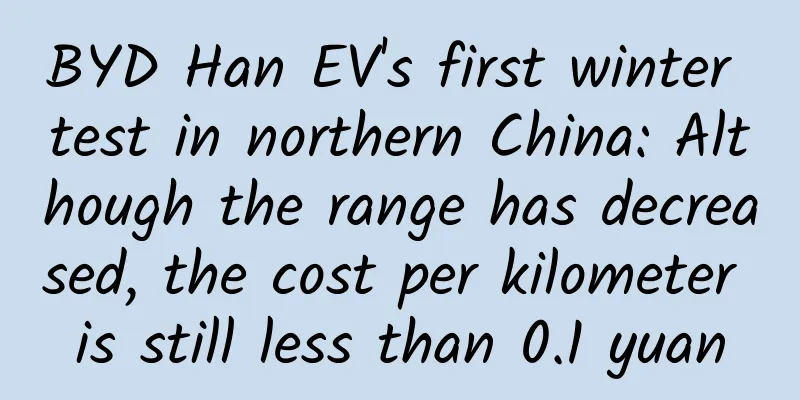BYD Han EV's first winter test in northern China: Although the range has decreased, the cost per kilometer is still less than 0.1 yuan

|
With brands such as BYD, Xpeng, and NIO making great strides in electric vehicle performance, experience, endurance, and intelligence, buying domestic electric vehicles has become the first choice for many prospective car owners. The BYD Han EV is the most talked-about car this year. It not only has powerful performance but also provides a superior driving experience and an ultra-long driving range of up to 605 kilometers. According to data released by BYD, despite the serious shortage of production capacity, the sales volume of Han reached 7,545 units in October, a month-on-month increase of 34.4%. On the Internet, the popularity of BYD Han EV reviews is also amazing. Almost all well-known car reviewers have tested Han EV. However, most of these evaluations were conducted before and after the Han EV was launched this summer. Based on the test results from various parties, its power consumption of about 14kW per 100 kilometers in urban areas is very close to the officially announced NEDC data. However, it is well known that the activity of lithium batteries will decrease at low temperatures, the internal resistance will increase, and additional energy loss will occur during discharge. This means that the battery life of electric vehicles will inevitably be compromised in cold environments. Therefore, many car owners in the north always have some concerns when purchasing electric vehicles. So, what is the actual situation? Recently, a five-day test was conducted on the Han EV Super Long Range Premium (hereinafter referred to as Han EV), in an effort to provide an objective data on the Han EV's northern winter range. The test location was Beijing, Shijiazhuang and Yangquan, Shanxi. Friends who are interested in the topic of Han EV's winter range may wish to pay attention to this review. First look: stylish exterior, luxurious interior Although everyone is already very familiar with it, as usual, we will still introduce the appearance design of Han EV first. However, given that there are too many similar articles, we will expand on it here. Han was first launched as a sports car, and this is even more evident in Han EV. Compared with the hybrid Han DM, Han EV has a more dynamic front face, with through-type headlights and bottom lines that give the front a more three-dimensional feel. From the front, Han EV has a sporty feel of a low-lying sports car. From the side, the sporty style of the front of the car does not run through the whole car. The waistline extending from the front disappears at the rear door. The rear of the car has another style, with a more restrained shape. The top performance version also indicates a 0-100km/h acceleration of 3.9 seconds under the "Han" character at the rear, frankly acknowledging its sports car genes. The model tested is the BYD Han EV long-range premium model. Compared with the top-end version, it mainly lacks a complete rear-axle drive system, and the acceleration from 0 to 100 km/h is reduced to 7.9 seconds, but its advantages are also outstanding. With the same 76.9kW battery capacity, the NEDC range is increased to 605 kilometers. Do you want a longer battery life or a longer battery life? BYD gives you both choices. I believe that with a price difference of more than 30,000 yuan and the temptation of longer battery life, most car owners will still prefer this model. After all, who doesn’t like a big filling and a cheap price? Han EV is a pure electric vehicle and a standard medium-to-large car, with a length, width and height of 4.98 meters, 1.91 meters and 1.49 meters respectively. The 2.92-meter long wheelbase is reflected in the spacious interior and the executive-level rear space. The seat size is large enough to support the thighs of the rear passengers. Even a 200-pound fat man will have a distance of more than two and a half fists from the front seat after sitting down, which is enough to cross his legs easily. In terms of interior, the outstanding appearance of Han EV is largely due to the work of former Mercedes-Benz designer Michele JAUCH-Paganetti. In his aesthetic vision, the addition of a large amount of black real wood and brown Nappa calfskin has transformed BYD's interior in terms of materials and colors, completing the key leap from a grocery shopping car to an image-enhancing car. Overall, the appearance and interior of Han EV completely surpass all models on the market under 300,000 yuan, and the driving experience it provides is not inferior to that of luxury cars of different levels. From strength to technology: powerful performance and smart technology Next, let's talk about the dynamic part. Han EV is BYD's first electric car equipped with lithium iron phosphate blade batteries, with a battery capacity of 76.9KW. The long-range version adopts a front-wheel drive design, with a 163kW permanent magnet synchronous motor at the front of the car, a total motor torque of 330N.M, and an acceleration of 7.9 seconds per 100 kilometers. Compared with the 3.9-second data of the four-wheel drive performance version, it is indeed a big gap, but it is completely sufficient for daily use. As electric vehicles have a more rapid power response, the Han EV can accelerate from 0 to 100 km/h in 7.9 seconds, which is not inferior to the 5-6-second acceleration of gasoline vehicles. You can also feel the full power when overtaking. In terms of braking performance, the Han EV's braking distance per 100 km is 32.8 meters, which currently ranks first among models of the same price, which is excellent. In terms of actual driving experience, the Han EV accelerates very smoothly without any sense of jerkiness. Of course, this is the advantage of electric vehicles. However, considering that many electric vehicles can't even do this well, we have to admit that BYD has accumulated quite a lot of experience in tuning electric vehicles. In addition, the Han EV's kinetic energy recovery also deserves a thumbs up. Even with a large feedback, BYD can adjust the resistance to be extremely linear, and the car will basically not experience setbacks or deceleration during kinetic energy recovery. Especially after the driver has adapted to this mechanism, he can even keep the kinetic energy recovery in the "largest" gear, and accelerate and decelerate with just one pedal in the city, thereby achieving a longer range. BYD Han EV uses a front McPherson + rear multi-link suspension combination. During driving, the suspension is moderately tuned and can absorb certain vibrations, but it will also provide appropriate road feel, and the overall suspension feels good. It has to be mentioned that the Han EV provides excellent sound insulation effect. The front and rear windshields are both made of double-layer glass. In addition, the chassis has good noise insulation performance. The motor is also quiet enough when running, and there is no howling at high speed. The overall noise control level in the car is in line with the performance of this level of vehicles. In terms of DiPilot assisted driving, BYD Han EV supports lane reminders, lane keeping, cruise control, automatic parking (not yet installed), lane change reminders, and traffic sign recognition. Here we will only introduce its cruise control function. Combined with the numerous sensors on the body, the cruise control of Han EV has also become more intelligent. When choosing cruise control, Han EV will use millimeter-wave radar to scan the distance to the vehicle in front, and automatically select the lower speed from "fixed speed" and "speed of the vehicle in front" to execute, giving priority to driving safety. In short, compared with other models of the same category, Han EV has basically achieved differentiated competition in assisted driving, and is powerful enough in some commonly used functions, providing a driving experience that is reassuring enough. Electric car or electric frozen car? Han EV low temperature endurance test Next is the winter battery life part that everyone is most concerned about. The discharge efficiency of lithium batteries in cold environments is not optimistic. Although the safety factor of lithium iron phosphate is high enough, the loss in winter faces more severe challenges than ternary lithium batteries. In response to this, BYD has designed a new blade-type packaging method to increase the energy density of lithium iron phosphate batteries, and uses PTC heating in the battery module to alleviate performance defects caused by low temperatures. The data speaks for itself. During the five-day test, the car traveled a total of 978 kilometers, with an actual power consumption of 204.8kW. The detailed road conditions, vehicle conditions, and power consumption during the actual driving are shown in the following figure: From the data, we can clearly feel that the Han EV is relatively durable in the first 50% of the power, and can even perform beyond the NEDC data in downtown Beijing in winter. It actually drove 17 kilometers, and the displayed mileage was only 14 kilometers. It drove 21 kilometers in Shijiazhuang city with a full charge, and the displayed mileage was only 20 kilometers. However, just like other electronic products including iPhones, once the battery level is low, the Han EV's battery level will drop quickly. When the battery level was only 19, during the 12-kilometer actual journey from Shijiazhuang to Zhengding, 38 kilometers of mileage were used up on the dashboard. It turns out that although lithium iron phosphate has made a lot of "patch" work on the endurance problem, due to the characteristics of basic chemical science, the consistency of battery release is still a basic problem in the scientific community. Therefore, whether in the cold north or the warm south, when driving any electric car, don't trust the last section of the mileage display too much, and try to charge it in time to avoid embarrassment. It is also worth mentioning that the BYD Han EV can dynamically adjust the mileage according to the actual driving conditions. The first box of electricity shows that it can travel 600 kilometers, and the second full charge shows that the mileage becomes 553 kilometers. Therefore, there is a slight difference in the ratio of the average power consumption before and after and the mileage displayed in the table. The following table compares the mileage of Han EV in urban areas and on highways: From the test results, it can be seen that thanks to its drag coefficient as low as 0.233, the Han EV's high-speed power consumption performance in low-temperature environments is significantly better than other "electric frozen cars" of the same level on the market. As for the result that the average power consumption per 100 kilometers in the city is higher than the highway driving performance, it is believed that it is more because most of the city driving is performed with low power, and we fully charged the Han EV before each highway test. Obviously, the power in the first half is obviously more durable, so when driving in the city with a full charge, the actual driving mileage is longer than the displayed mileage. On the whole, in the cold winter in the north, if you use the Han EV's Eco mode to achieve greater kinetic energy recovery and turn on the heater throughout the journey, you can basically maintain an average power consumption of 20 kW per 100 kilometers, and the cruising range can be maintained around the baseline. In terms of high-speed energy consumption, which is generally poor for electric vehicles, the Han EV has indeed optimized it, and its performance is not much different from that in the city. In addition, actual tests have shown that whether the air conditioner is turned on or off does not have a particularly large impact on the battery life of the Han EV, so car owners in the north don't have to deliberately make things difficult for themselves, and they can turn on the air conditioner without hesitation. Cost advantage no longer in winter? Low temperature charging time and cost test The reason why electric cars are often jokingly called "electric dads" is mainly to make fun of the driving anxiety caused by their lack of range and charging convenience. However, as the industry matures and products become more popular, domestic facilities are also improving rapidly. According to relevant data, the State Grid invested 2.7 billion yuan in charging piles this year, and built 78,000 new charging piles, a year-on-year increase of 35.5 times. Data is boring, but feelings are real. During the long test, the most intuitive feeling is that the difficulty of finding charging piles is decreasing exponentially. When driving the Han EV through Beijing-Shijiazhuang-Shanxi-Beijing, almost all rest areas provide charging piles. After actual testing, the charging power is mostly around 40kW, and the Han EV can be charged more than half in one hour. It is worth mentioning that Han EV's voice assistant Xiaodi can also help find and navigate to the nearest charging station. Taking Shijiazhuang as an example, there are indeed a large number of abandoned charging stations in the city, but Xiaodi and the State Grid App can still directly view nearby available charging stations, and can also check the number of idle stations in real time. The most important thing is that parking is free. Considering the current situation, most car owners do not have charging piles installed in their parking spaces. So in order to simulate a more realistic situation, we charged the car on the charging piles of the State Grid during the test days. The specific charging data and price statistics are as follows: From the cost tables of our several charging sessions, we can see that electricity prices will fluctuate greatly depending on the peaks and troughs. The charging price at 3 a.m. is only 0.33 yuan/kW, and including the service fee it is only 0.43 yuan/kW. However, during the day, the most expensive electricity price will rise to 0.72 yuan/kW. It should be noted that at present, highways are still not very friendly to electric vehicles, at least the charging price does not reflect enough goodwill. At highway service areas, the charging service fee has exceeded the electricity price, reaching 1 yuan/kW. In total, the price per kW has reached 1.55 yuan, which is really not cheap. Even though the highway service fee is relatively expensive and there are differences in peak and valley electricity prices, the overall cost advantage of electric vehicles is still quite obvious. Let's do some calculations. If a fuel-efficient vehicle is calculated based on a fuel consumption of 7L/100km, the price of 92-grade gasoline is 5.55 yuan/L, which is equivalent to 0.39 yuan per kilometer. In summer, the average power consumption of Han EV is about 15kW per 100km. The electricity price range is calculated based on the 0.43-1.55 yuan/kW in this test, and the electricity price per kilometer is in the range of 0.06-0.23 yuan; In the northern winter environment, the average power consumption per 100 kilometers is calculated based on the 21kW obtained in this test, and the electricity price per kilometer fluctuates between 0.09 and 0.32 yuan. The lowest cost per kilometer is still no more than 0.1 yuan, which is truly amazing. In other words, considering the cost of use, there is no doubt that electric vehicles crush fuel vehicles. And as long as you don't charge your vehicle during peak hours with high electricity prices or in service areas with high service fees, the cost of electricity consumption will definitely have an order of magnitude advantage over fuel vehicles, even in the northern winter when battery efficiency drops significantly. Viewpoint: "Han" has a special meaning to the Chinese people. The Han Dynasty created the Chinese history that has continued to this day, and the Han and Tang Dynasties are also the most brilliant existence in our long history. Similarly, for BYD, "Han" is also of great significance. The Han series, especially the electric series, carries the historical mission of BYD's brand leap. With its stylish appearance, excellent performance, ultra-long driving range, and luxury car driving experience, BYD Han EV has won unanimous recognition from consumers. Despite the extremely insufficient production capacity and the need to wait for several months to pick up the car, it still achieved sales of 7,545 units in October. According to BYD insiders, the main factors that drag down BYD Han's production capacity are the lithium iron phosphate blade batteries and the production capacity shortcomings of Nappa leather and real wood for car interiors. When the supply chain increases its efforts, the production capacity will keep up with the demand rhythm of sales. After several days of testing, the lithium iron phosphate blade battery is truly worthy of its reputation. In the winter in the north, the battery life of the Han EV showed extremely high stability, especially as Tesla owners recently complained that the lithium iron phosphate Model 3 had a poor range in winter, which further demonstrated the technical advantages of the blade packaging. In fact, from the long-term test experience, when facing international-level competitors, our domestic electric vehicle brands really no longer need to look up to them, let alone belittle themselves. Because in terms of interior quality, driving range, and driving experience, models like BYD Han EV are no longer inferior to Tesla Model 3. Buying a car means experiencing a lifestyle on wheels, from the nine-to-five work from sunrise to sunset, to the relaxing and comfortable commuting from one city to another. The performance of Han EV is remarkable. Even in some key points, such as battery life and driving experience, it surpasses its peers. If you need to change the pace of your life, Han EV should not let you down. As a winner of Toutiao's Qingyun Plan and Baijiahao's Bai+ Plan, the 2019 Baidu Digital Author of the Year, the Baijiahao's Most Popular Author in the Technology Field, the 2019 Sogou Technology and Culture Author, and the 2021 Baijiahao Quarterly Influential Creator, he has won many awards, including the 2013 Sohu Best Industry Media Person, the 2015 China New Media Entrepreneurship Competition Beijing Third Place, the 2015 Guangmang Experience Award, the 2015 China New Media Entrepreneurship Competition Finals Third Place, and the 2018 Baidu Dynamic Annual Powerful Celebrity. |
<<: After so many years of talking about large-screen OLED, are they all safe now?
Recommend
All you need to create high-conversion information flow promotion ideas is these few tricks!
What kind of creative has a high click-through ra...
How to use the Foshan maternal and child mini program? How to promote the maternal and child mini program mall?
After the country relaxed the "three-child p...
"A bumper harvest" to celebrate the autumn harvest! Wait, what does "a bumper harvest" mean?
In the golden autumn of October, fruits and veget...
Popular Science | Pineapples are not only edible, but can also be a luxury item?
It's the season for pineapples again. Pineapp...
How to use soft articles to create word-of-mouth marketing?
Word-of-mouth marketing is a widely used promotio...
How to apply star-chasing publicity channels to brand marketing?
The channels used by star-chasing fans to promote...
What are the network promotion outsourcing companies in Chengdu?
There are many online marketing companies, but th...
Qifen Academy "Sister-in-law's Emotional Intelligence Class"
Qifen Academy "Sister-in-law's Emotional...
Interview with Jim Zemlin, Executive Director of the Linux Foundation: Open source has gone from being a niche genre to being known to everyone
The LC3 (LinuxCon + ContainerCon + CloudOpen) con...
Enjoy mobile life Lenovo Tablet S8 outdoor experience review
The just concluded 11.11 Shopping Festival showed...
Xiaomi Mi Box Enhanced Edition Full Analysis
The Xiaomi box uses the Amlogic S802 processor, wh...
List of "Science" Rumors in December 2022: Can Yangkang produce antibodies in 15 days? Can sweating reduce fever?
The list of "scientific" rumors for Dec...
How to do website bidding promotion and how to do it well?
It has been more than a year since I switched fro...
[Powerful] D3.js visualizes the number of SSH brute force attacks
This blog post is from 51CTO blogger Lao Xu_kevin...
Cheng Guangjian sales negotiation and professional payment collection skills video
Mr. Cheng Guangjian has worked for companies incl...
![[Creative Cultivation Program] Go crazy with sunflower seeds snacks, but don’t forget to pay attention to this thing in the packaging bag](/upload/images/67f262645c1ff.webp)








